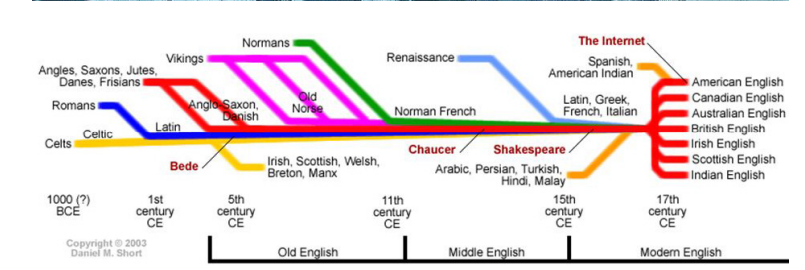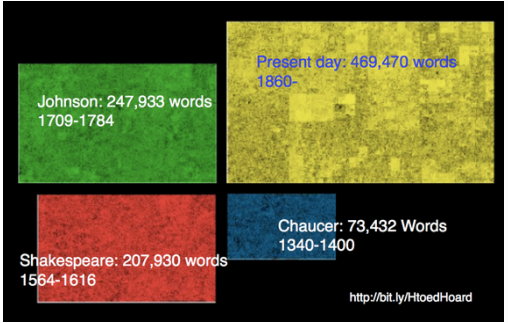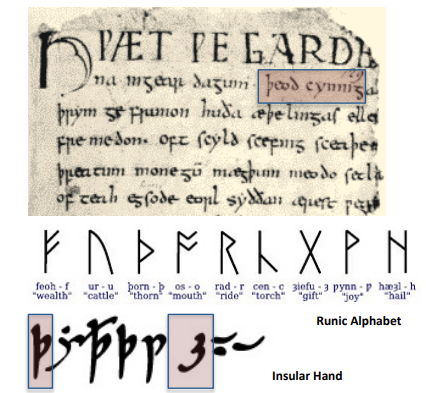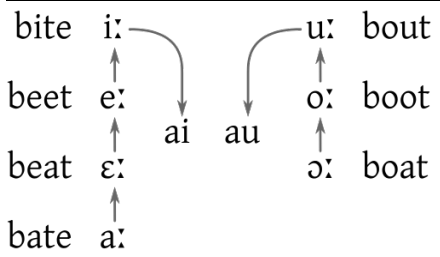блаблаблаблеблебле
1/36
There's no tags or description
Looks like no tags are added yet.
Name | Mastery | Learn | Test | Matching | Spaced |
|---|
No study sessions yet.
37 Terms
Pre-English Period
up until 450 AD; Roman soilder; Celtics Tribes ; romans
Timeline of English
1 PRE-ENGLISH
2 OLD ENGLISH
3 MIDDLE ENGLISH
4a EARLY MODERN EN
4B MODERN ENGLISH

Old English Period
from 450 AD to 1150 AD; William the Conqueror;
Middle English Period
1150 AD to 1500 AD; Geoffrey Chaucer
Early Modern English Period
1500 AD to 1700 AD; William Shakespeare
Modern English Period
1700 AD to 1900 AD.
English
A West Germanic Language with similarities to German.
Indo-European Languages
Languages that have strongly influenced English, including French, Latin, and Greek.
Latin, Germanic, and French
Languages that make up the large bulk of the English vocabulary.
GROWTH OF ENGLISH
The lexicon of English has been continuously expanding through the ages

Old English (OE) – Writing
was first written using runes, but from around 800, most texts used a version of the Latin alphabet called insular script, which included special letters like thorn (þ) for /θ, ð/ and yogh (ȝ) for /j/ or /ŋ/.

Old English Vocabulary
had Germanic roots (e.g. bite, drink), few Celtic words (like Dover), many Latin borrowings (e.g. street, paper), and strong Scandinavian influence (e.g. knife, window).
Old English Vocabulary (Viking)
From around 800 to 1085, Old Norse from Scandinavian settlers influenced English, adding many words (like sky, skill), place names, and sounds like sk, k, and g.
Old English Grammar
was highly inflected, like modern German, with 4 cases, singular/plural forms, and strong and weak nouns and verbs (e.g. speak/spoke/spoken).
Old English Syntax
Old English had flexible word order because of inflections, but as these endings were lost, word order became more fixed to show meaning.
Middle English (ME) – Vocabulary
During the ME period English borrows 10.000 words from French. Most of them (75%) remain in current use.
Middle English (ME) – Spelling
Printing began in 1476, helping standardize English. Modern spelling reflects Late Middle English, which used doubled letters for sound and revived Latin-style spellings.
Early Modern English (EME) – Hard Words
Interest in old languages and subjects added many words to English, but some were too strange and disliked—called inkhorn terms.
Early Modern English – Vocabulary/Borrowing
Many new English words came from Latin, French, Greek, Italian, Spanish, and Portuguese for science, medicine, law, and trade.
EME – Phonology (Great Vowel Shift GVS)
a major change in English pronunciation where all long vowels changed: lower vowels became higher, and higher vowels turned into diphthongs.

Early Modern English2 – Shakespearean English
kept some old endings, used new tenses, changed pronouns, and spelling became more regular.
The Spread of English in the Empire
In the 1600s, English began spreading worldwide through colonization, leading to new types like American, Australian, and Indian English.
Language Change
The continuous alteration of languages despite systematic grammar.
External Cause
A major factor that motivates language change; includes language contact and borrowing.
Internal Cause
A major factor that motivates language change; includes phonological/sound changes.
Changing Worlds
The naming of new cultural artifacts requiring new words.
Laziness – A Powerful Engine of Change
1 Clipping/Shortening: Goodbye << god be with ye (1560
2 Abbreviations/Blends: romcom << romantic comedy
3 Grammaticalization:Bealdlíce >> boldly (Adv. ) – OE
Economy of Effort
leads to abbreviations and shortenings of all kinds, also to simplifications in grammar.
The desire for clarity and recognizable distinctions.
leads to reorganizations of the language system and to new expressions/meanings.
Politeness
The avoidance of offense through new synonymous expressions.
Misunderstandings
A mis- or re-interpretation of structure, meaning, and etymology.
Borrowing from prestigious donor languages.
enriches the vocabulary of English and leads to semantic differentiation.
Types of Change
1.LEXICAL
2.SEMANTIC
3.PHONOLOGICAL
4.SYNTACTIC
Lexical Change
Word stock increases and changes.
Semantic Change
Senses of words change.
Phonological Change
Sound structure of words changes.
Syntactic Change
Grammar of words and clauses changes.